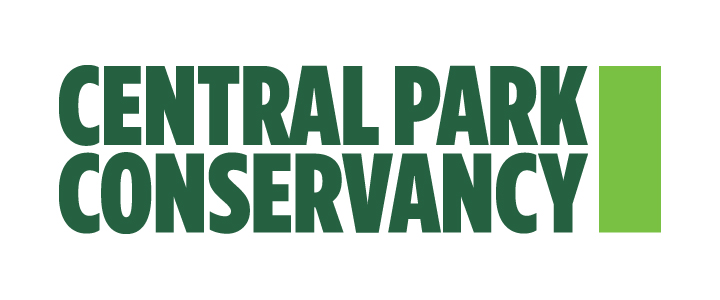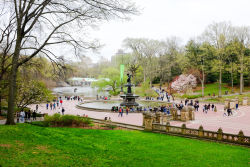Central Park
Public Events and Activities Honor the 150th Anniversary of Design Selection
72nd Street Cross Drive Renamed “Olmsted & Vaux Way”
“The urban parks movement of the 19th century was the result of the immediate success of Central Park; every major city in the nation created parks based on New York’s exemplary public space,” says Douglas Blonsky, President of the Central Park Conservancy and Central Park Administrator. “Today, it is one of the world’s great urban spaces, and we are pleased that in its 150-year history the Park has never looked more beautiful or been better managed.”
Blonsky continues, “The restoration and maintenance of our nation’s historic parks has become today’s challenge, and once again Central Park, through the Conservancy, is at the forefront of that movement. In 2008, we celebrate the significance of this American masterpiece as well as its phenomenal recovery.”
“A great social experiment was begun in New York City 150 years ago when Frederick Law Olmsted and Calvert Vaux designed Central Park,” says NYC Parks & Recreation Commissioner Adrian Benepe. “Over the last 28 years, the Central Park Conservancy and the City of New York have teamed up to restore this masterpiece of landscape design and manage it as the great public backyard for New Yorkers and visitors — 25 million a year.”
- Celebrating Greensward exhibition in the Arsenal: April 23 through June 19
This special exhibition celebrates the history of the Park, its landscape and use, subsequent deterioration, and recent transformation by the Conservancy.
- The 72nd Street Cross Drive was renamed as “Olmsted & Vaux Way” in honor of their immeasurable contribution to the City of New York at an unveiling ceremony: Monday, April 28, 2008.
The Bank of New York played a crucial role in the design of Central Park, when bank Director John A.C. Gray, on the advice of Calvert Vaux, convinced fellow Park Commissioners to hold a design competition for the Park. In honor of this historic connection, The Bank of New York Mellon supports some of the events and activities during the anniversary celebration.
The story of Central Park’s design begins with Calvert Vaux, a young determined British architect, who moved to America in 1850 to create homes and estates for the Hudson River clientele of landscape designer Andrew Jackson Downing. Downing had promoted the idea of a large New York City park in his magazine, The Horticulturalist. In 1852, Downing drowned in a Hudson River steamboat accident and in 1856 Vaux moved to New York City to establish his architectural practice.
Vaux approached Park Superintendent Frederick Law Olmsted to enter the design competition with him. The winning design plan, which Olmsted and Vaux named “Greensward,” from the English term for “unbroken stretch of turf or lawn,” was innovative and visionary.
“Central Park in the 1850s was America’s greatest example of the marriage of aesthetics and engineering. Above ground it is a designed landscape that copies nature so closely that it disguises its own fabrication, and below ground, it is an efficient technological system,” says Sara Cedar Miller, author of the book, Central Park, An American Masterpiece, and the Central Park Conservancy’s Park photographer and historian.
Few people are aware that the Park is entirely man-made with the exception of the rock outcrops. Most of the Park’s meadows were created by draining the swamps and filling them with tens of thousands of cartloads of soil. The Park’s lakes were the result of water flowing through the same system of pipes that also filled the bathtubs and kitchen sinks of New Yorkers.
One of the principal reasons why the Greensward plan won the competition was its unique approach to addressing the need for at least four east/west traffic crossings. Ahead of their time, Olmsted and Vaux proposed to sink these transverse roads. This technological innovation ¾ combined with strategically placed vegetation ¾ creatively screens out the crosstown traffic from public view, freeing Park visitors of the noise and bustle of the City, thus creating what the designers’ referred to as “a single work of art.”
When the Greensward plan was selected in 1858, 106th Street was the northern terminus of the future Park, but it was modified in 1863 to add the land up to 110th Street. The landscapes of the Park were completed in 1873.
The Central Park Conservancy’s mission is to restore, manage, and preserve Central Park, in partnership with the public, for the enjoyment of present and future generations.
The Central Park Conservancy is a private, not-for-profit organization founded in 1980 that manages Central Park under a contract with the New York City Department of Parks & Recreation. Thanks to the generosity of many individuals, corporations, foundations, and the City of New York, the Conservancy has invested more than $450 million to date into the Park, making it a model for urban parks worldwide. The Conservancy provides 85 percent of Central Park's $27 million annual operating budget and is responsible for all basic care of the Park. For more information on the Greensward Anniversary and the Central Park Conservancy, visit www.centralparknyc.org.
Check out your park's Vital Signs
Clean & Safe
Green & Resilient
Empowered & Engaged Users
Share your feedback or learn more about how this park is part of a
Vital Park System

Know Before You Go
Anticipated Completion: Spring 2024
Anticipated Completion: Spring 2025

Contacts
Central Park Information: (212) 310-6600
Central Park Information (for the Hearing Impaired): (800) 281-5722
Belvedere Castle, The Henry Luce Nature Observatory: (212) 772-0210
The Charles A. Dana Discovery Center: (212) 860-1370
The Dairy Visitor Center and Gift Shop: (212) 794-6564
North Meadow Recreation Center: (212) 348-4867
Loeb Boathouse (Bike rentals, boat rentals & gondolas): (212) 517-2233
Carousel: (212) 879-0244
Fishing at Harlem Meer (Catch & Release): (212) 860-1370
Harlem Meer Performance Festival: (212) 860-1370
Horseback Riding - Claremont Stables: (212) 724-5100
Metropolitan Opera (Performances on the Great Lawn): (212) 362-6000
New York Philharmonic (Performances on the Great Lawn): (212) 875-5709
Shakespeare in the Park - The Public Theater at the Delacorte Theater: (212) 539-8655
Central Park SummerStage: (212) 360-2777
Swedish Cottage Marionette Theater: (212) 988-9093
Tennis: (212) 280-0205
Weddings, Ceremonies and Photography at the Conservatory Garden: (212) 360-2766
Wildlife Center & Tisch Children's Zoo: (212) 439-6500











